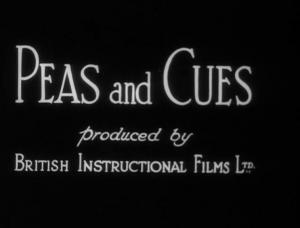Peas and Cues (S)
- Original title
- Peas and Cues
- Year
- 1930
- Running time
- 9 min.
- Country
 United Kingdom
United Kingdom- Director
- Cast
-
Documentary
- Producer
- Genre
- Documentary | Short Film. Nature. Educational
- Synopsis
- Peas and Cues was the first Secrets of Nature film to have a sound commentary. In their memoirs, Percy Smith and Mary Field recalled the dramatic circumstances of its production. They had been approached: with an offer to put on one of our 'Secrets of Nature' with the first night of Douglas Fairbanks' Taming of the Shrew, but the 'Secret' had to be a "sound-film". We had never made one.
In the rush to meet the deadline, the sound recording was made at a Welwyn studio, but the first three attempts were failures caused by a workman's nearby hammering dislodging the tone-lamp in the sound camera by a hundredth of an inch.
Despite the teething troubles, Peas and Cues was, according to Field and Smith, an audience success: "the first, and to many people the most lovely, of all the talking 'Secrets of Nature'". Partly this success can be attributed to the simple 'life story' structure that is now a cliché in nature film narratives. The film shows the birth, life and reproduction of sweet peas, a familiar and well loved plant of British gardeners. The commentary personalises the life story further by likening the germinating and growing plant to a boisterous human youngster. The seed is the 'cradle of the baby green pea plant', while the plant is a 'vigorous child'.
While sweet peas might be familiar objects, and therefore an effective means to connect with the audience, the movement of growing plants, captured and revealed through gorgeous time-lapse cinematography, is unfamiliar and potentially disturbing. Plants seem to be moving like animals. In Peas and Cues, however, this uncanny movement of plants is presented as endearing rather than, as was the case with The Strangler (1930), on the parasitic dodder plant, sinister.
There are hints of natural theology - the drawing of morals from nature - but never such as to distract from the aesthetic spectacle of moving living plants. For example, the contrasting fate of the two seeds, one falling on barren land, the other growing in fertile soil, would have been immediately suggestive to church-going viewers. Less directly religious is the moral that life on earth is a cycle of hard work in which flashes of beauty are temporary and brief. "Once more", the commentator concludes, "there is a struggle of growth and endeavour", in which the "all too fleeting beauty of the flower" is merely part.
Jon Agar (bfi screenonline)
- Movie Soulmates' ratings
-
Register so you can access movie recommendations tailored to your movie taste.
- Friends' ratings
-
Register so you can check out ratings by your friends, family members, and like-minded members of the FA community.
Is the synopsis/plot summary missing? Do you want to report a spoiler, error or omission? Please send us a message.
If you are not a registered user please send us an email to [email protected]
If you are not a registered user please send us an email to [email protected]
All copyrighted material (movie posters, DVD covers, stills, trailers) and trademarks belong to their respective producers and/or distributors.
For US ratings information please visit: www.mpaa.org www.filmratings.com www.parentalguide.org
 US
US  Canada
Canada  Mexico
Mexico  Spain
Spain  Ireland
Ireland  Australia
Australia  Argentina
Argentina  Chile
Chile  Colombia
Colombia  Uruguay
Uruguay  Paraguay
Paraguay  Peru
Peru  Ecuador
Ecuador  Venezuela
Venezuela  Costa Rica
Costa Rica  Honduras
Honduras  Guatemala
Guatemala  Bolivia
Bolivia  Dominican Rep.
Dominican Rep. 
